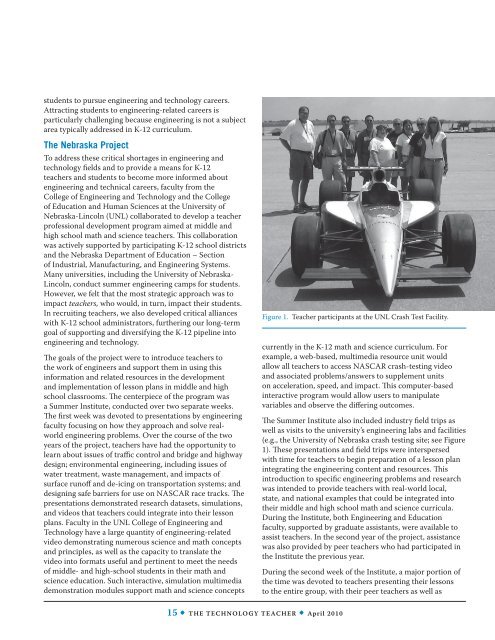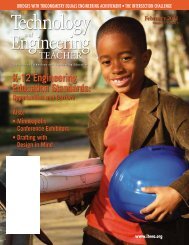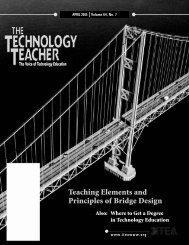Medical Technology: organ harvesting and Transplants
Medical Technology: organ harvesting and Transplants
Medical Technology: organ harvesting and Transplants
You also want an ePaper? Increase the reach of your titles
YUMPU automatically turns print PDFs into web optimized ePapers that Google loves.
students to pursue engineering <strong>and</strong> technology careers.<br />
Attracting students to engineering-related careers is<br />
particularly challenging because engineering is not a subject<br />
area typically addressed in K-12 curriculum.<br />
The Nebraska Project<br />
To address these critical shortages in engineering <strong>and</strong><br />
technology fields <strong>and</strong> to provide a means for K-12<br />
teachers <strong>and</strong> students to become more informed about<br />
engineering <strong>and</strong> technical careers, faculty from the<br />
College of Engineering <strong>and</strong> <strong>Technology</strong> <strong>and</strong> the College<br />
of Education <strong>and</strong> Human Sciences at the University of<br />
Nebraska-Lincoln (UNL) collaborated to develop a teacher<br />
professional development program aimed at middle <strong>and</strong><br />
high school math <strong>and</strong> science teachers. This collaboration<br />
was actively supported by participating K-12 school districts<br />
<strong>and</strong> the Nebraska Department of Education – Section<br />
of Industrial, Manufacturing, <strong>and</strong> Engineering Systems.<br />
Many universities, including the University of Nebraska-<br />
Lincoln, conduct summer engineering camps for students.<br />
However, we felt that the most strategic approach was to<br />
impact teachers, who would, in turn, impact their students.<br />
In recruiting teachers, we also developed critical alliances<br />
with K-12 school administrators, furthering our long-term<br />
goal of supporting <strong>and</strong> diversifying the K-12 pipeline into<br />
engineering <strong>and</strong> technology.<br />
The goals of the project were to introduce teachers to<br />
the work of engineers <strong>and</strong> support them in using this<br />
information <strong>and</strong> related resources in the development<br />
<strong>and</strong> implementation of lesson plans in middle <strong>and</strong> high<br />
school classrooms. The centerpiece of the program was<br />
a Summer Institute, conducted over two separate weeks.<br />
The first week was devoted to presentations by engineering<br />
faculty focusing on how they approach <strong>and</strong> solve realworld<br />
engineering problems. Over the course of the two<br />
years of the project, teachers have had the opportunity to<br />
learn about issues of traffic control <strong>and</strong> bridge <strong>and</strong> highway<br />
design; environmental engineering, including issues of<br />
water treatment, waste management, <strong>and</strong> impacts of<br />
surface runoff <strong>and</strong> de-icing on transportation systems; <strong>and</strong><br />
designing safe barriers for use on NASCAR race tracks. The<br />
presentations demonstrated research datasets, simulations,<br />
<strong>and</strong> videos that teachers could integrate into their lesson<br />
plans. Faculty in the UNL College of Engineering <strong>and</strong><br />
<strong>Technology</strong> have a large quantity of engineering-related<br />
video demonstrating numerous science <strong>and</strong> math concepts<br />
<strong>and</strong> principles, as well as the capacity to translate the<br />
video into formats useful <strong>and</strong> pertinent to meet the needs<br />
of middle- <strong>and</strong> high-school students in their math <strong>and</strong><br />
science education. Such interactive, simulation multimedia<br />
demonstration modules support math <strong>and</strong> science concepts<br />
Figure 1. Teacher participants at the UNL Crash Test Facility.<br />
currently in the K-12 math <strong>and</strong> science curriculum. For<br />
example, a web-based, multimedia resource unit would<br />
allow all teachers to access NASCAR crash-testing video<br />
<strong>and</strong> associated problems/answers to supplement units<br />
on acceleration, speed, <strong>and</strong> impact. This computer-based<br />
interactive program would allow users to manipulate<br />
variables <strong>and</strong> observe the differing outcomes.<br />
The Summer Institute also included industry field trips as<br />
well as visits to the university’s engineering labs <strong>and</strong> facilities<br />
(e.g., the University of Nebraska crash testing site; see Figure<br />
1). These presentations <strong>and</strong> field trips were interspersed<br />
with time for teachers to begin preparation of a lesson plan<br />
integrating the engineering content <strong>and</strong> resources. This<br />
introduction to specific engineering problems <strong>and</strong> research<br />
was intended to provide teachers with real-world local,<br />
state, <strong>and</strong> national examples that could be integrated into<br />
their middle <strong>and</strong> high school math <strong>and</strong> science curricula.<br />
During the Institute, both Engineering <strong>and</strong> Education<br />
faculty, supported by graduate assistants, were available to<br />
assist teachers. In the second year of the project, assistance<br />
was also provided by peer teachers who had participated in<br />
the Institute the previous year.<br />
During the second week of the Institute, a major portion of<br />
the time was devoted to teachers presenting their lessons<br />
to the entire group, with their peer teachers as well as<br />
15 • The <strong>Technology</strong> Teacher • April 2010

















